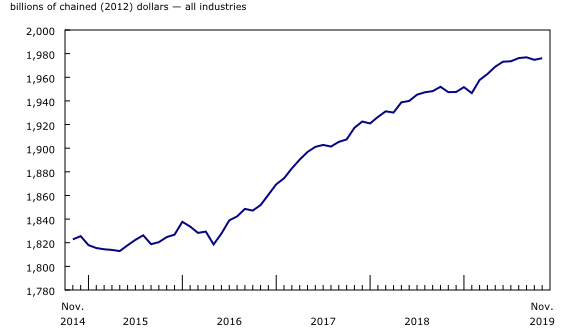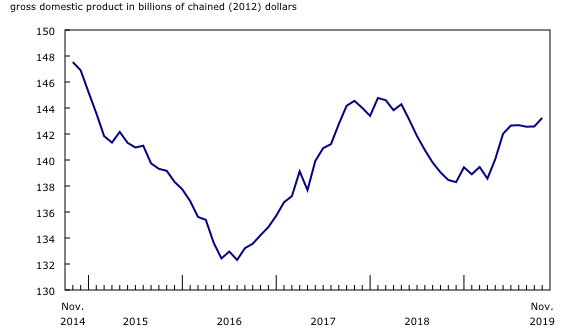Gross domestic product by industry, November 2019
Archived Content
Information identified as archived is provided for reference, research or recordkeeping purposes. It is not subject to the Government of Canada Web Standards and has not been altered or updated since it was archived. Please "contact us" to request a format other than those available.
Released: 2020-01-31
November 2019
0.1% 
(monthly change)
Real gross domestic product (GDP) edged up 0.1% in November, offsetting most of the decline in October. Increases in 15 of 20 industrial sectors more than offset notable declines in the mining, quarrying and oil and gas extraction and transportation and warehousing sectors, influenced partly by disruptions in rail transportation service and crude oil pipeline transportation.
Goods-producing industries edged up 0.1% after posting declines in September and October, while services-producing industries also edged up 0.1%.
On a three-month rolling average basis, GDP was up 0.1%, down from a 0.2% increase in October.
Utilities up because of colder weather in central Canada
A major factor in November's increase in GDP was a 2.1% rise in utilities, as a result of unseasonably cold weather in central Canada. This marked the largest growth in utilities in over a year.
Construction rises as all subsectors increase
After three months of stagnation, the construction sector was up 0.5% in November, with growth in all subsectors. Residential construction rose 0.6% on growth in alterations and improvements and apartment construction. Non-residential construction grew 0.4% because of a rise in the commercial sector. Both repair construction, and engineering and other construction activities increased 0.4%.
Retail recoups part of the decline in October
After a widespread 1.1% decline in October, retail trade increased 0.5% in November with gains in 5 of 12 subsectors. Motor vehicle and parts dealers were up 2.4%, led by increases at new car dealers and other motor vehicle dealers. Building material, garden equipment and supplies stores grew 2.7%, marking a first increase in four months. Activity in store types typically associated with Black Friday promotions was mixed: electronic and appliance stores were up 1.5%, while clothing and clothing accessories stores (-1.5%) and sporting goods, hobby, book and music stores (-1.9%) were down for the third and fifth consecutive months, respectively.
Mining, quarrying and oil and gas extraction down
The mining, quarrying and oil and gas extraction sector decreased 1.4% in November. Mining and quarrying except oil and gas (-4.0%) contributed the most to the decline as non-metallic minerals (-8.6%) fell for the fifth time in six months. Potash mining declined 18.2% because of the temporary closure of a number of mines in Saskatchewan stemming from weaker international demand. Metal ore mining was down 2.8%, with declines in iron ore (-12.9%) and copper, nickel and zinc (-3.1%) mining.
Support activities for mining, and oil and gas extraction were down 5.5% from lower rigging and drilling services.
Oil and gas extraction increased 0.8% in November, up for a third consecutive month. Oil and gas extraction (except oil sands) was up 1.5% as crude petroleum production increased at Newfoundland and Labrador offshore production facilities, which reached their highest level of production since January 2009.
Transportation and warehousing declines
The transportation and warehousing sector (-0.9%) was down for the fifth time in six months as two events reduced its production capacity.
Rail transportation (-3.8%) was down for the third month in a row, influenced by an eight-day strike that reduced Canada's rail transportation capacity. Pipeline transportation (-2.2%) declined for a third time in four months as a pipeline closure which continued into November contributed to slower crude oil transportation. Air transportation (+1.3%) was up more than 1% for a third consecutive month.
Wholesale declines in back-to-back months
Wholesale trade declined 0.4% and was down for a second consecutive month for the first time since December 2018. Four of the nine subsectors recorded losses, led by a 2.5% decrease in miscellaneous wholesalers, reflecting lower activity from wholesalers of agricultural supplies, such as potash. The motor vehicle and motor vehicle parts wholesaling subsector (-2.1%) was down for the fourth consecutive month, reflecting—in part—production shutdowns at automotive assembly plants, as well as auto worker strikes. Wholesaling of machinery, equipment and supplies was up 1.0%, partially compensating for the setback in October.
Manufacturing essentially unchanged
Manufacturing was essentially unchanged in November, as declines in non-durable manufacturing (-1.4%) offset increases in durable manufacturing (+1.2%).
The declines in non-durable manufacturing were led by decreases in chemical manufacturing (-5.4%), which were driven by contractions in pharmaceutical and medicine manufacturing, and in pesticides, fertilizer and other agricultural chemical manufacturing. Food manufacturing (-2.7%) was down because of declines in the manufacturing of meat products and fruit and vegetable preservatives.
Increases in durable manufacturing can be attributed to growth in transportation equipment (+3.4%), specifically in motor vehicles and parts, as many establishments ramped up the pace of their activities following labour disruptions in previous months. These increases were partially offset by losses in electrical equipment (-8.1%) and primary metals (-2.7%) manufacturing, with many enterprises being negatively affected by interruptions in rail transportation.
Other industries
House resale activity at the offices of real estate agents and brokers (+1.3%) grew for the ninth consecutive month in November. Housing resale activities in Montréal, Toronto and Vancouver were the main contributors, with Vancouver leading the growth since July 2019.
Finance and insurance was essentially unchanged in November, as increases in banks and other non-depository intermediation (+0.2%), and financial investment services, funds and other financial vehicles (+0.2%) were offset by a decline in insurance carriers and related activities (-0.6%).
Accommodation and food services increased 0.4% because of increased activity in food services and drinking places (+0.6%).
Sustainable development goals
On January 1, 2016, the world officially began implementing the 2030 Agenda for Sustainable Development—the United Nations' transformative plan of action that addresses urgent global challenges over the next 15 years. The plan is based on 17 specific sustainable development goals.
The release on gross domestic product by industry is an example of how Statistics Canada supports global sustainable development goal reporting. This release will be used to help measure the following goal:

Note to readers
Monthly data on gross domestic product (GDP) by industry at basic prices are chained volume estimates with 2012 as the reference year. This means that the data for each industry and each aggregate are obtained from a chained volume index multiplied by the industry's value added in 2012. The monthly data are benchmarked to annually chained Fisher volume indexes of GDP obtained from the constant-price supply and use tables (SUT) up to the latest SUT year (2016).
For the period starting in January 2017, data are derived by chaining a fixed-weight Laspeyres volume index to the prior period. The fixed weights are 2016 industry prices.
This approach makes the monthly GDP by industry data more comparable with expenditure-based GDP data, which are chained quarterly.
All data in this release are seasonally adjusted. For information on seasonal adjustment, see Seasonally adjusted data – Frequently asked questions.
For more information on GDP, see the video "What is Gross Domestic Product (GDP)?"
Revisions
With this release of monthly GDP by industry, revisions have been made back to January 2019.
Each month, newly available administrative and survey data from various industries in the economy are integrated, resulting in statistical revisions. Updated and revised administrative data (including taxation statistics), new information provided by respondents to industry surveys, and standard changes to seasonal adjustment calculations are incorporated with each release.
Real-time table
Real-time Table 36-10-0491-01 will be updated on February 10, 2020.
Next release
Data on GDP by industry for December 2019 will be released on February 28, 2020.
Products
The User Guide: Canadian System of Macroeconomic Accounts (13-606-G) is available.
The Methodological Guide: Canadian System of Macroeconomic Accounts (13-607-X) is also available.
The Economic accounts statistics portal, accessible from the Subjects module of the Statistics Canada website, features an up-to-date portrait of national and provincial economies and their structure.
Contact information
For more information, contact us (toll-free 1-800-263-1136; 514-283-8300; STATCAN.infostats-infostats.STATCAN@canada.ca).
To enquire about the concepts, methods or data quality of this release, contact Ederne Victor (613-863-6876), Industry Accounts Division.
- Date modified:




